Introduction:
Norfolk Island is a small island in the Pacific Ocean located between Australia, New Zealand, and New Caledonia, 877 miles directly east of mainland Australia’s Evans Head, and about 560 miles from Lord Howe Island. Together with the two neighboring islands Phillip Island and Nepean Island it forms one of the Commonwealth of Australia’s external territories. At the 2016 Australian census, it had 1748 inhabitants living on a total area of about 14 square miles. Its capital is Kingston.

The first known settlers in Norfolk Island were East Polynesians but they were long gone when Great Britain settled it as part of its 1788 settlement of Australia. The island served as a convict penal settlement from 6 March 1788 until 5 May 1855, except for an 11-year hiatus between 15 February 1814 and 6 June 1825, when it lay abandoned. On 8 June 1856, permanent civilian residence on the island began when it was settled from Pitcairn Island. In 1914 the UK handed Norfolk Island over to Australia to administer as an external territory.
The evergreen Norfolk Island pine is a symbol of the island and is pictured on its flag. Native to the island, the pine is a key export for Norfolk Island, being a popular ornamental tree on mainland Australia, (where two related species grow), and also worldwide.
History:
Polynesian Settlement:
Norfolk Island was settled by East Polynesian seafarers either from the Kermadec Islands north of New Zealand or from the North Island of New Zealand. They arrived in the thirteenth or fourteenth century, and survived for several generations before disappearing. They must have disappeared at least a few hundred years before Europeans arrived as the island was covered with forest by then.
First Penal Settlement (1788–1814):
The first European known to have sighted and landed on the island was Captain James Cook, on 10 October 1774, on his second voyage to the South Pacific on HMS Resolution. He named it after Mary Howard, Duchess of Norfolk (c. 1712 – 1773).
Sir John Call argued the advantages of Norfolk Island in that it was uninhabited and that New Zealand flax grew there. In 1786 the British government included Norfolk Island as an auxiliary settlement, as proposed by John Call, in its plan for colonization of New South Wales. The decision to settle Norfolk Island was taken due to Empress Catherine II of Russia’s decision to restrict sales of hemp. Practically all the hemp and flax required by the Royal Navy for cordage and sailcloth was imported from Russia.

When the First Fleet arrived at Port Jackson in January 1788, Governor Arthur Phillip ordered Lieutenant Philip Gidley King to lead a party of 15 convicts and seven free men to take control of Norfolk Island and prepare for its commercial development. They arrived on 6 March 1788.
During the first year of the settlement, which was also called “Sydney” like its parent, more convicts and soldiers were sent to the island from New South Wales.
